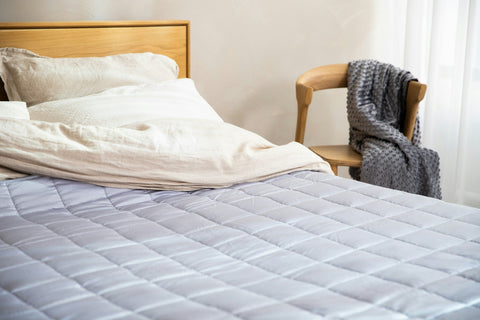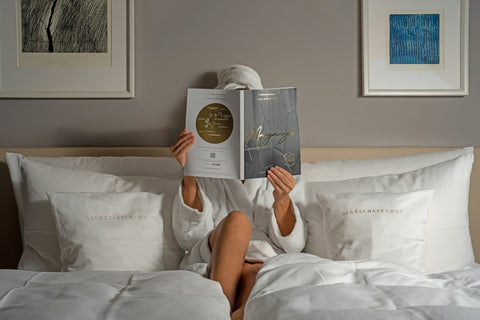
You finally get the chance to climb into bed after a long day. But once you settle in, you can’t seem to get comfortable. You toss and turn, feeling stuffy and too hot before finally kicking your duvet to the floor. The following day, you wake up exhausted with no clue how to choose a duvet to help you sleep better. If you can relate to this scenario, you’re not alone. Many struggle to understand the different types of duvets and their unique characteristics to find the ideal match for their personal preferences. In this guide, we’ll explore the various types of duvets to help you find the best duvet insert that delivers personalized comfort, ideal temperature regulation, and a luxurious sleep experience every night.
One of the best solutions to help you achieve your goals and sleep more soundly is Yumerest’s cloud-like fluffy duvets. These cozy, breathable duvets offer the luxurious comfort and temperature control you need to get a better night’s sleep.
What is a Duvet?

Coming from the French word which translates to down (feathers), a duvet is a blanket composed of two parts:
-
Stuffing made of lightweight fillers that trap body heat to provide continuous warmth while remaining breathable
-
Separate duvet cover, where the outer layer exposed to the elements can be removed and is easy to wash regularly
Duvets are commonly used in Europe as an all-in-one bedding solution, combining fitted sheets and other bed coverings on top of your bed. Their convenience and versatility have made duvets a staple in homes worldwide. Duvets make making your bed and cleaning effortless.
Cover Convenience
Duvet covers, which act as the top and bottom layers that interact with our skin the most, can be washed like a bedsheet. For more style-conscious users, a duvet with a cover makes changing your bed theme simple. The fact that the duvet comes in two parts also means it takes some coordination to get the blanket in one piece, and clumping may still occur while in use.
To keep everything in place, Weavve offers Lyocell covers and the best cotton duvet covers with:
-
Back envelope openings
-
Bartacks
-
Elastic bands
-
Corner ties
Duvet vs. Quilt – What’s the Difference?
A blanket of Latin origin, the quilt is the product of a classic art of stitching together pieces of fabric with padding stuffed in between. The stitching pattern can vary from squares to intricate zigzags.
In olden times, a traditional quilt held much meaning as it patched together the story of one’s life, given to people:
-
For marriage
-
Having children
-
For a rite of passage, as children grow up
Quilt Comparison
As such, a quilt cover is a bed accessory which is of:
-
High monetary
-
Sentimental value
Choosing between a quilt and a duvet depends on your need for warmth. While the primary purpose of both the duvet and the quilt is the same, they differ in execution. The quilt padding is much thinner than a duvet, which may shortchange those sleeping in colder climates unless remedied by layering blankets.
Quilt Drawbacks
Since the quilt is a one-piece blanket, it is difficult to launder regularly. Aesthetically, the quilt pattern lends an old-school feel, which may only work for select themes. The versatility of modern duvet covers, which are easily changed and washed, can fit any bedroom design. You can quickly change the look of your bed by changing the covers.
Before buying a duvet or a quilt, it is recommended that you take note of your room's climate and make the choice based on that.
Duvet vs. Comforter – What’s the Difference?
A comforter is similar to a duvet in its level of fluff and type of stuffing, but the likeness ends there. One of the favorite hotel bedding items, this blanket is a one-piece accessory usually denoted by a standard pattern of big squares with filling in between to provide warmth.
The comforter’s grid pattern ensures that the filling will always be evenly distributed, whether the comforter is moved or not. A comforter is an excellent choice for something clean and simple that can be easily added in layers to your entire bed.
It can be less versatile than the flexibility offered by duvet covers. Due to their composition and thickness, comforters have dry-clean-only washing instructions. Before deciding between a comforter and a duvet, it is recommended that you see if you have access to a dry cleaner.
Related Reading
- Best Down Alternative Comforter
- Best Goose Down Comforter
- Best Fluffy Comforter
- How to Choose a Down Comforter
7 Major Types of Duvets

1. Hollow Fibre Duvets: Affordable and Allergy-Friendly
Hollow fibre duvets offer a budget-friendly starting point for anyone purchasing a new duvet. These synthetic fibre duvets are:
-
Easy to clean
-
Machine washable
-
Great for allergy sufferers who dislike natural fillings like down or feathers
The main downside of hollow fibre duvets is that they don't last long. You can expect an average lifespan of around five years, about half that of a natural-filled duvet.
2. Microfiber Duvets: A Soft and Lightweight Alternative
Microfiber duvets, like hollow fibre duvets, contain synthetic filling. The two are different. Microfiber is designed to mimic the softness of down. The ultra-fine fibers result in a lightweight duvet that offers cozy comfort without the heavy feel of wool or hollow fiber options.
If you want a soft duvet but dislike the weight of other options, consider microfiber. This duvet type has a relatively short lifespan.
3. Wool Duvets: Natural Comfort Year-Round
Wool duvets appeal to those looking for a natural filling. They have a heavier feel than most options but excel at providing comfort year-round. Wool reacts to your body temperature, keeping you:
-
Warm when it’s cold
-
Cool when it’s hot
This quality ensures that you feel comfortable no matter the season. Wool is also more eco-friendly than synthetic fiber since it’s:
-
Renewable
-
Biodegradable
Wool Downsides
And it’s naturally hypoallergenic, making it a good choice for those with allergies. The main downside of wool duvets is the price. Expect to pay more for a good-quality option. With proper care, wool duvets can last for over a decade.
4. Silk Duvets: Temperature Regulating and Luxurious
Silk duvets feature another natural filling with excellent temperature control qualities. Depending on the season, they’ll keep you warm or cool, making silk duvets ideal for those who want something they can use comfortably throughout the year.
Silk is considered a luxurious material, so the duvets are expensive. Silk duvets:
-
Last long
-
Hypoallergenic
-
Naturally resistant to allergens like dust mites
5. Goose Down Duvets: Lightweight Warmth with a Luxurious Feel
Goose down duvets are one of the premium fillings for duvets. The down feathers have no spine and are excellent insulators. These duvets are usually extraordinarily light but snug and cozy. They are typically filled with 85 to 90 percent down, with the remaining filling made up of duck or goose feathers.
Some down duvets can go up to 100 percent. Down duvets are excellent insulators, but can be too good. For some sleepers, the insulation can cause discomfort. This is why the tog rating is essential when choosing your down duvet.
6. Hungarian Goose Down: The Top Choice for Luxury and Comfort
Hungarian goose down duvets are wonderfully light and comfortable, offering unparalleled warmth and a cloud-like feel. Considered the best down filling on the market, they are of high quality and provide a luxuriously soft and blissful sleep experience unrivaled by other products.
Hungarian goose down consists of large spherical clusters of down. This structure creates air bubbles, allowing the duvet to contour to the shape of your body while still maintaining its shape. The air pockets make the down resilient to stress and prevent it from losing shape, ensuring the duvet maintains its functionality for a long time.
Hungarian Down
Hungarian geese have adapted to their harsh climate, and their feathers provide them with the thermal qualities they need to survive. Thus, their down is of high quality and provides a luxuriously soft and warm sleep experience with ultimate heat insulation.
7. Siberian Goose Down: The Best Choice for Cold Climates
Providing luxury, warmth, and durability, a Siberian goose down duvet is the top choice for colder climates. Siberian goose down is naturally airy and insulating without weighing you down. The duvets are also naturally breathable and lightweight, helping to maintain your body temperature for extra comfort.
With their superior fill-power, this duvet is lighter and loftier than our Hungarian down duvet. It’s perfect for the winter months to keep you wonderfully warm. The geese from which the down is sourced can survive in one of nature’s coldest climates. The insulating properties of the down make this duvet ideal for people living in colder regions.
Other Types of Duvets: Assessing Tog, Size, and Filling
Aside from the types of duvets mentioned above, there are a few more categories to consider when looking for a new duvet. These categories include:
-
Tog
-
Size
-
Filling
A Quick Note on Tog Ratings
Tog is a measure used to indicate how warm a duvet is. The higher the tog, the warmer the duvet. If you live in a cold area or want a winter-friendly duvet, get a 10.5 to 15 tog duvet. Look for a lower tog duvet if you want something comfortable for summer or if you are a hot sleeper.
Some duvet sets come with two duvets with different tog ratings for use in other seasons. Here are the standard tog ratings by season.
-
Summer: 2.5 to 9
-
Spring and autumn: 6 to 10.5
-
Winter: 10.5 to 15
You can also find extra-warm duvets that go up to 18 tog.
By Size
Most duvets are available in multiple sizes, from cot and single to super king and emperor. Here are the dimensions for the most common sizes.
-
Single: 135 x 200 cm
-
Double: 200 x 200 cm
-
King: 230 x 220 cm
-
Super King: 260 x 220 cm
-
Emperor: 290 x 235 cm
Hypoallergenic vs. Anti-Allergy
These two terms are standard when it comes to duvets. They both mean the duvet is ideal for allergy and asthma sufferers and individuals with sensitive skin. They don’t mean the same thing. A hypoallergenic duvet is made from materials that rarely cause allergic reactions.
Examples include:
-
Wool
-
Silk
An anti-allergy duvet or pillow means it has been treated to be more resistant to allergens like dust mites.
Related Reading
- Best Comforter Material for Hot Sleepers
- Best Duvet Cover Material
- Best Comforter for Allergies
- Duvet Tog Guide
- Best Duvet for Night Sweats
Which Duvet Should You Choose to Sleep Well?
 When shopping for a duvet insert, pay close attention to the materials. The best duvets typically feature a soft, breathable cotton shell filled with natural down or fluffy down-alternative fibers. These materials will provide warmth and insulation while preventing you from overheating. They also excel at wicking away sweat while you doze.
When shopping for a duvet insert, pay close attention to the materials. The best duvets typically feature a soft, breathable cotton shell filled with natural down or fluffy down-alternative fibers. These materials will provide warmth and insulation while preventing you from overheating. They also excel at wicking away sweat while you doze.
Look for Certifications That Ensure Quality
A down comforter might be certified by the Responsible Down Standard (RDS). This ensures the fibers are sourced from live birds treated humanely and not harmed. The fabric shell may also carry the Oeko-Tex Standard 100 label.
This textile certification tells you the material was made without over 100 substances that could harm you or the environment.
Consider Fill Power for a Fluffy Duvet
Fill power tells you how fluffy and voluminous a duvet insert or comforter is. Measured in cubic inches, it's the volume of one ounce of fill fibers. A high-quality duvet often has a fill power of at least 700, the higher the number, the loftier it will be. A high fill power doesn't necessarily indicate a warmer or heavier duvet.
It only refers to the volume, so a higher number of products will take up more storage space, but they will also give your bed a fluffier look and feel.
Consider Fill Weight for Temperature Regulation
Weight is different from fill power. Usually measured in ounces, it tells you the weight of your duvet's down or down-alternative fill. Fill weights for the best duvet inserts and comforters typically range from 400 to 800 ounces.
The numbers are intuitive. Smaller numbers usually indicate lightweight comforters; higher numbers imply the duvet is heavier. In some cases, a duvet won't list an actual fill-weight number. The bedding brand might just label the product as:
-
Lightweight
-
Medium-weight (or all-season)
-
Heavy (sometimes called winter weight)
Fill Power
While a higher fill power has nothing to do with warmth, the fill weight does. A lighter-weight duvet will sleep more comfortably than a heavier design.
Baffle-Box Construction for Even Warmth and Distribution
The best duvets will feature baffle-box construction. This means the fiber-filled fabric shell is stitched into squares (sometimes called pockets) like a quilt. The technique prevents the down or down-alternative fibers from bunching up, ensuring the fill is evenly distributed and that the duvet remains fluffy through years of use.
Care Instructions: Make Sure Your Duvet Is Easy to Clean
You'll want to examine the care instructions for the duvet you're buying. Most down and down-alternative inserts are machine-washable using cold or warm water on delicate cycles. Some call for spot-cleaning only, and others may recommend dry-cleaning. A machine-washable design is generally ideal, as it's the most convenient.
Size Matters When Choosing a Duvet
Like mattresses and sheets, duvets come in various bedding sizes, including:
-
Twin
-
Twin XL (extra-long)
-
Full
-
Queen
-
King
-
California king (also called Cal king)
You'll sometimes see the sizes combined, such as twin/twin XL, full/queen or king/Cal king. If you like a fuller look and feel, think about sizing up. If your bed is a queen, you can get a king-sized comforter and stuff it into a queen-sized duvet cover.
Price and Value of Duvets
Comforter and duvet insert prices typically range from $100 to $1,000. That said, the best duvets are often priced somewhere in the middle, between $250 and $550. It's possible to overpay. You can pay more for natural down than down-alternative.
Get Deep Sleep Every Night with Our Cloud-like Soft Fluffy Duvets

Yumerest specializes in cloud-like soft fluffy duvets that transform any bedroom into a luxurious sanctuary. The company’s PureFlow Duvet features an exceptional 5kg fill of ethically sourced Northern down that promotes deeper, more restorative sleep.
Yumerest’s duvets stand apart from competitors like Happy Fluffy Cloud and Hush because of their temperature-regulating abilities. The premium Canadian duvet never gets too hot or too cold. It envelops you in perfectly cozy warmth year-round. Expert artisans craft Yumerest’s duvets using techniques perfected since 1946.
PureFlow Bundle
The duvets combine traditional craftsmanship with modern innovation for an unparalleled sleeping experience. The complete PureFlow bundle features the heavenly duvet, an elegant cover, and a calming sleep mist to create a complete sleep sanctuary that helps busy professionals and parents finally achieve the rejuvenating rest they deserve.
Get deep sleep every night with our cloud-like fluffy duvets.
Related Reading
- Best Hotel Style Comforter
- How to Choose a Duvet
- How to Make a Duvet Fluffy
-
Best Comforter Filling Material







